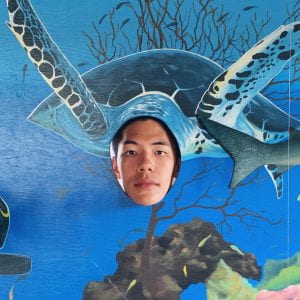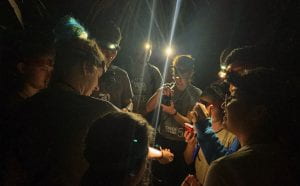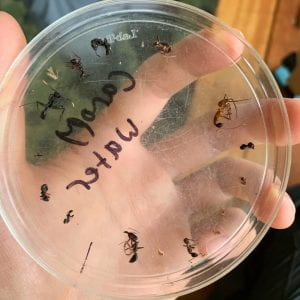Since returning to Houston, I’ve become a surprisingly effective multitasker. Now I can reflect on our incredible Tropical Field Biology trip (and even write a blog!) while itching my sand fly bites. Every minute in Belize was packed with learning, from niche ecological interactions like epiphytes strangling host trees, to foundational ecological concepts, such as the crucial role of nitrogen in ecosystems and how it’s more abundant in the leaf litter of forest floors.
But what made this learning unforgettable was how we experienced it – though fun and freakish ways like working with our own pee. Experiencing ecological concepts through hands-on experimentation made them so much more vivid, real, and memorable than any diagram or paragraph ever could. Learning by doing, we all became jungle explorers and reef divers, adventuring to the fullest soaking up knowledge everywhere we went.
As a part of this class, I became the taxon expert on two interesting and seemingly unrelated groups: epiphytes (non-parasitic plants that grow on other object for support) in the rainforest and sponges (not the synthetic kind) on the sea floor. I choose them because they seemed super cool and were unfamiliar to me, but I didn’t take notice of the extreme similarities between them. After all, they lived in nearly opposite ecosystems and were from two entirely different taxonomic kingdoms (plants and animals). What traits could they possibly share?
As it turns out, far more than I expected. Both rely on external surfaces to latch on to, without typically harming their hosts. Certain species of epiphytes and sponges can reproduce asexually by growing genetically identical organisms from a piece of the original. They are also highly resourceful, pulling in nutrients from their surroundings, with epiphytes capturing from the air and debris and sponges from filtered water. And some epiphytes and sponges even excrete chemical defenses (phytochemicals for epiphytes) to ward off predators and compete for space. Despite living in drastically different environments, both fill their own unique, specialized niches and employ similar living strategies, proving that successful survival and living adaptations rise above ecosystem classifications.
As we transitioned from the rainforest to the jungle, we were trying to identify the “ants of the reef.” While no reef organism seemed to match the ants’ sophisticated behaviors of fungal garden cultivation and eusocialty, some shared a few similar traits and adaptations. For example, both ants and hermit/land crabs burrow into the ground and create networks of tunnels for living and refugee from predators above the surface. These are examples of convergent evolution, which are similar adaptations or behaviors evolving in entirely different environments.
Beyond specific adaptations, elements of the rainforest and reef often resemble each other in their physical nature. Leaves in the canopy swayed in the breeze like sea fans in the current. But my response to the sun in both ecosystems was loading up on electrolytes and shading myself with long sleeves and broad rimmed hats. Both ecosystems baked under the same tropical sun, with rainforest epiphytes reaching higher ground to chase light, and island reptiles seeking shader to escape it. Though my response to the sun in both locations was loading up on electrolytes and relying on my broad-brimmed hat. We ventured through two ecosystems that seemed infinitely different at first glance but upon further examination, hosted organisms with remarkably similar survival strategies in the face of competition for space and resources and abiotic constraints of sunlight, precipitation, and water storage.
DSCF1655 (1) (Waving Sea Fans – 05/25/25)
I think that this course exceeded every expectation and scenario I crafted in my head. I imagined we’d be perusing around the rainforest and snorkeling while stopping to discuss species ID and conduct experiments. Nothing could’ve prepared me for how intriguing, weird, and unique the experience would actually be. I wouldn’t have dreamed about seeing textbook examples like ant fungal gardens or Cecropia tree ant apartment complexes, which seemed too exotic, rare, and far off from our realities.
DSCF1315 (1) (Cecropia Apartment Complex – 05/19/25)
I have to say that some of my favorite moments were trudging through the crunchy, leafy trails, getting to know classmates while laughing so genuinely at the crazy, absurd parts of our trip and the nerdy eco-jokes we created – running away from bright green light-in-the-dark beetles; the distinct and recognizable feline smell (cat pee) in different places and our hopes for spotting a jaguar or puma; and the yummy snacking termites.
Now back in Houston, I’ve already found myself sharing Belize stories over lunch. Today, I explained leaf-cutter ant fungal garden cultivation to my friend Joseph while showing him a picture of the fungal garden we dug up – the perfect, most appetizing lunch conversation. Yesterday, the TFBs still in Houston went out for ramen and reminisced about inside jokes and crazy animals and species interactions we learned about. We passed by a plant shop on our walk to the restaurant, saw epiphytes lining the windows and walls, and couldn’t help but pose for a selfie, knowing that it would end up in my reflection blog. The ecological facts and experiences are fresh in my mind and ready to be shared in my everyday conversations.
(Houston Plant Shop with Epiphytes! – 06/01/25)
I see the concepts we learned about everywhere, especially with epiphytes. It’s exciting to recognize them in Houston, though the diversity here is much lower. This is probably because these is less diversity in Houston vegetation in general, as most of the green was probably plants intentionally after the natural coastal prairie ecosystems were moved down and replaced by cement. Because the trees are less diverse, it would make sense that the specialized epihpytes that live on them are also far less diverse, with the two most common types I’ve seen being Spanish moss and the Resurrection Plant. Both live on the live oaks around campus, so it’s a daily treat to see them on my walks.
(Resurrection Plant on Rice Outer Loop – 05/31/25)
I’ve picked up some valuable life lessons too. I now keep electrolyte packets on hand whenever I work at the garden under Houston’s blazing sun, which is still much less intense than the Central American sun. I also am super thankful for the luxuries of cold, refrigerated water, clean (nonsandy) sheets, and clean underwear.
(Electrolyte Packet Order – 06/01/25)
But most of all, I’ve learned to treasure the beauty of green spaces, the peace of waking up to birdcalls, and having much to learn from the infinite wisdom shared by local experts and natural guides. Whether spotting the national flower of Belize (the Black Orchid) growing on a tree trunk or tasting jungle snacks and remedies like sour leaves for liver health or vine water on a hot day, the experiences of Belize were such a gift.
Peace out,
Lily H. 🙂 2025






